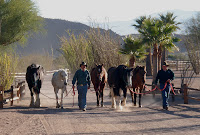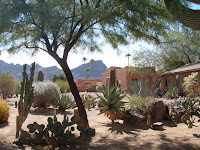On our way from Arizona to Las Vegas, we realize we will be passing close by the western rim of the Grand Canyon, where the new Skywalk has recently opened. Richard and I have never seen the Grand Canyon, so we decide to take advantage of this opportunity. Skywalk is a glass walkway that takes you right over the canyon. Apparently it makes you feel like a bird or a giddy bighorn as you look straight down.
It's on Native American land and lots of people tell us we'll get "scalped".
"They'll charge you $30 each just to park there," says one fellow traveller.
"It'll cost you at least $100 each to visit," says another.
The first traveller is wrong, the second is about right. But it's worth every penny. And hats off to the
Hualapai nation for doing something apart from opening another casino on reservation land. The first delight is the drive from Kingman to the Grand Canyon West. The road is deserted two-lane blacktop for most of the way. We glide through arid desert with Joshua trees and dramatic rock formations. For about 5 miles the road is rough but they are working hard to pave it and soon it will be smooth and easy.
It takes us maybe 90 minutes and we arrive at a strange white pod. A guard tells you where to park. You go to the pod and buy your ticket. For $45 you get the Skywalk, a shuttle to Guano Point and an optional free excursion to the Hualapai Ranch with a cowboy lunch included.
The shuttles are big air-conditioned buses spaced about 15 minutes apart, so no site becomes too congested. We are here on a Sunday in November. Sunday is actually a good day to visit. It's one of their quiet times, because most of their visitors are from Las Vegas and tours usually leave on Saturday and arrive on Sunday.
Richard suffers from vertigo and opts not to do the Skywalk, but there's plenty for him to do while Jennifer and I step over a 4000 foot precipice. He visits an Indian craft shop and finds me a medicine bag, one of the things I wanted to find on this trip. There are also replica Indian dwellings that you can go into.
Jennifer and I put our backpacks, purses, cameras and binoculars in the free lockers provided and go up a ramp to the Skywalk. They give you little paper slippers to put over your shoes so you don't scratch the surface. This is the same reason you can't take your camera or binoculars. People might drop them and make the glass less transparent.
For me, the giddiness comes not from looking straight down, but from the view out over the rail at the Colorado river miles below, and a helicopter the size of a gnat flying along it. If you have an extra $70 per person you can take a helicopter ride from here. They take off almost every ten minutes... and this is a quiet day!
We catch the shuttle bus to Guano Point five minutes away, and I find this even more breathtaking than the Skywalk. It's almost deserted and there is no rail at all on the precipice. You could plunge right over if you wanted. A pair of ravens are soaring and diving above the void and brave souls peer over the edge to see the the rusted remains of a car sent over the edge for a movie (not Thelma and Louise).
You can have a coffee here at Guano Point, and there are restroom facilities as there are at the Skywalk.
To get to the Ranch you go right back to the ticket pod and catch a different bus. It takes less than ten minutes and brings you to a fun replica Western town with humorous signs and gravestones in the cemetery. At the Trading Post we have a lunch of chicken, corn on the cob and coleslaw (you can have ribs and baked potatoes if you like) and iced tea or soft drinks. The lunch is mediocre but it's a fun setting.
After lunch, the three of us wander over to a card dealer. I want to ask him about the finer points of Faro, a popular card game in the period my books are set. But it turns out he is more than a dealer. He does card tricks. He gives us the best magic demonstration I have ever seen. Jennifer writes her name on a card and he does all sorts of impossible things with it. I'm trying to look for sleight of hand but this guy is GOOD! His name is Mark Crow and he's Vegas quality. No. Better.
Outside in the beautiful November weather (78 degrees and blue sky) I stike up a conversation with cowboy Steve who tells me about a famous celebrity who lives on the Ranch, Norman, the steer from the movie City Slickers! (Read more on my entry
Meeting Norman.)
After looking around the ranch a little more, we get the shuttle back to the ticket pod and pick up our car. Las Vegas is only an hour or two away, with the Hoover Dam and its new bridge on the way for a convenient break.
So would I recommend a visit to the
Hualapai site of Grand Canyon West?
Definitely. Getting "scalped" was never so fun.






















































